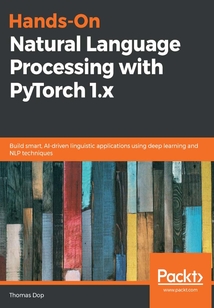舉報 

會員
Hands-On Natural Language Processing with PyTorch 1.x
Intheinternetage,whereanincreasingvolumeoftextdataisgenerateddailyfromsocialmediaandotherplatforms,beingabletomakesenseofthatdataisacrucialskill.Withthisbook,you’lllearnhowtoextractvaluableinsightsfromtextbybuildingdeeplearningmodelsfornaturallanguageprocessing(NLP)tasks.StartingbyunderstandinghowtoinstallPyTorchandusingCUDAtoacceleratetheprocessingspeed,you’llexplorehowtheNLParchitectureworkswiththehelpofpracticalexamples.ThisPyTorchNLPbookwillguideyouthroughcoreconceptssuchaswordembeddings,CBOW,andtokenizationinPyTorch.You’llthenlearntechniquesforprocessingtextualdataandseehowdeeplearningcanbeusedforNLPtasks.Thebookdemonstrateshowtoimplementdeeplearningandneuralnetworkarchitecturestobuildmodelsthatwillallowyoutoclassifyandtranslatetextandperformsentimentanalysis.Finally,you’lllearnhowtobuildadvancedNLPmodels,suchasconversationalchatbots.Bytheendofthisbook,you’llnotonlyhaveunderstoodthedifferentNLPproblemsthatcanbesolvedusingdeeplearningwithPyTorch,butalsobeabletobuildmodelstosolvethem.
目錄(67章)
倒序
- 封面
- 版權信息
- Contributors About the author
- About the reviewers
- Packt is searching for authors like you
- Preface
- Section 1: Essentials of PyTorch 1.x for NLP
- Chapter 1: Fundamentals of Machine Learning and Deep Learning
- Overview of machine learning
- Neural networks
- NLP for machine learning
- Summary
- Chapter 2: Getting Started with PyTorch 1.x for NLP
- Technical requirements
- Installing and using PyTorch 1.x
- Enabling PyTorch acceleration using CUDA
- Comparing PyTorch to other deep learning frameworks
- Building a simple neural network in PyTorch
- NLP for PyTorch
- Summary
- Section 2: Fundamentals of Natural Language Processing
- In this section……
- Chapter 3: NLP and Text Embeddings
- Technical requirements
- Embeddings for NLP
- Exploring CBOW
- Exploring n-grams
- Tokenization
- Tagging and chunking for parts of speech
- TF-IDF
- Summary
- Chapter 4: Text Preprocessing Stemming and Lemmatization
- Technical requirements
- Text preprocessing
- Stemming and lemmatization
- Uses of stemming and lemmatization
- Summary
- Section 3: Real-World NLP Applications Using PyTorch 1.x
- Chapter 5: Recurrent Neural Networks and Sentiment Analysis
- Technical requirements
- Building RNNs
- Introducing LSTMs
- Building a sentiment analyzer using LSTMs
- Deploying the application on Heroku
- Summary
- Chapter 6: Convolutional Neural Networks for Text Classification
- Technical requirements
- Exploring CNNs
- Building a CNN for text classification
- Summary
- Chapter 7: Text Translation Using Sequence-to-Sequence Neural Networks
- Technical requirements
- Theory of sequence-to-sequence models
- Building a sequence-to-sequence model for text translation
- Next steps
- Summary
- Chapter 8: Building a Chatbot Using Attention-Based Neural Networks
- Technical requirements
- The theory of attention within neural networks
- Building a chatbot using sequence-to-sequence neural networks with attention
- Summary
- Chapter 9: The Road Ahead
- Exploring state-of-the-art NLP machine learning
- Future NLP tasks
- Summary
- Other Books You May Enjoy
- Leave a review - let other readers know what you think 更新時間:2022-08-25 16:45:32
推薦閱讀
- Raspberry Pi 3 Cookbook for Python Programmers
- Learning AngularJS Animations
- Mastering Delphi Programming:A Complete Reference Guide
- INSTANT ForgedUI Starter
- 電腦維護365問
- Practical Machine Learning with R
- Arduino BLINK Blueprints
- 單片機系統設計與開發教程
- 龍芯自主可信計算及應用
- Corona SDK Mobile Game Development:Beginner's Guide
- 嵌入式系統設計大學教程(第2版)
- 筆記本電腦的結構、原理與維修
- The Machine Learning Workshop
- 零基礎輕松學修電腦主板
- ARM接口編程
- Practical Artificial Intelligence and Blockchain
- Arduino+3D打印創新電子制作2
- Applied Supervised Learning with R
- Hands-On Python Deep Learning for the Web
- Arduino項目開發:物聯網應用
- 中國SOA最佳應用及云計算融合實踐
- GateIn Cookbook
- ARM嵌入式體系結構與接口技術(Cortex-A9版)(微課版)
- 89C51單片機實用教程
- Pro Tools HD:Advanced Techniques and Workfl ows
- Arduino Android Blueprints
- Spring Cloud微服務:入門、實戰與進階
- Machine Learning with Swift
- Apache Kylin權威指南(第2版)
- 嵌入式系統軟硬件協同設計實戰指南:基于Xilinx ZYNQ(第2版)

